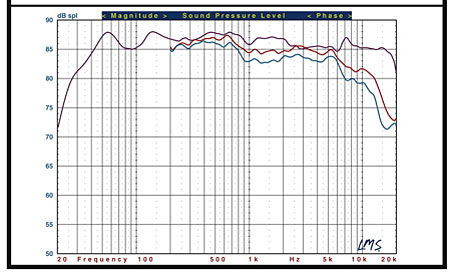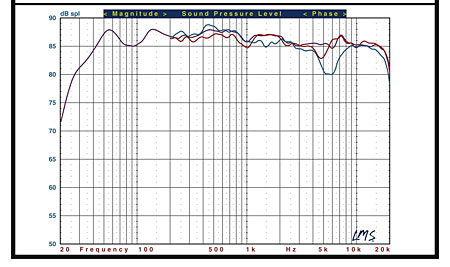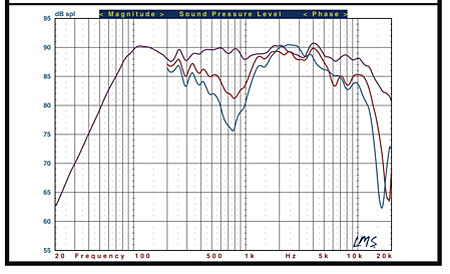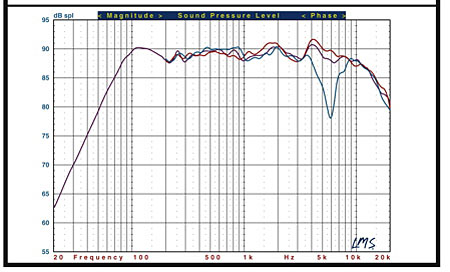The NHT Classic Four Surround Sound Speaker System Measurements
All the figures shown here on the Classic Four and Classic Three C were measured with the grilles removed. The grille only slightly degraded the averaged front axis response of the Classic Four, oddly in the form of a small peak at 12kHz. The effect on the Classic Three C with the grille in place was more pronounced, with an added +2dB peak at 1.7kHz and a -4dB dip at 3kHz in the averaged response.
The impedance of the Classic Four indicates a ported enclosure tuned to approximately 27Hz, with a minimum impedance of 5.2Ω at 143Hz. Its nominal specified impedance of 8Ω matched our measurements. The speaker's sensitivity is approximately 87dB/2.83V/m. It should be an easy load for any reasonably well-designed amplifier or AV receiver.
The horizontal front response of the Classic Four is shown in Fig.1 (violet). This is the pseudo-anechoic response averaged over a 30° forward horizontal angle, taken at tweeter height, combined with the nearfield responses of the woofer and port.

Fig.1: NHT Classic Four, pseudo-anechoic response off the horizontal axis at 45° (red) and 60° (blue).
This ±15° averaged front horizontal response is exceptionally smooth and extended. While nothing here suggests the cool upper bass/lower midrange that MF experienced, room/placement effects could be the most obvious culprits. The horizontal off-axis response follows the on-axis result closely, up to the expected off-axis HF rolloff. The effective lower limit of the bass (-10dB) is an impressive 22Hz relative to the output at 100Hz, confirming the robust bass that MF observed, once low frequency room gain is added into the equation.
Fig.2 shows the same averaged horizontal front response (purple), this time overlaid with the vertical responses taken at +15° (red) and –15° (blue). These curves suggest that you might not want to choose an ear position much below the tweeter, where there is a response suckout centered at 5.5kHz, but once that limit is observed the optimum vertical listening window should be easy to accommodate.

Fig.2: NHT Classic Four, pseudo-anechoic response at 15° above (red) and 15° below (blue) the tweeter axis.
The NHT Classic Three C's sealed cabinet is tuned to about 74Hz. Its minimum impedance measured 5.7Ω at 160Hz. Our measurements confirm its specified 8Ω nominal rated impedance. Its sensitivity measured approximately 89dB/2.83V/m, and like the Classic Four, it should be a relatively easy load to drive, even for the average AV receiver.
The measured front horizontal response of the Classic Three C, taken on the tweeter axis and averaged in the same manner as described above for the Classic Four (but no port in the Three C's sealed cabinet), is shown in Fig.3 (violet curve). The effective bass extension (-10dB) is approximately 51Hz relative to the output at 100Hz. The on-axis response is very smooth and flat, though oddly (with the same tweeter design on duty) slightly less extended at the extreme top end. But the off axis response at the wide 45° (red) and 60° (blue) angles we use for this measurement show a severe suckout of about 8dB at the smaller of these two angles and 14dB at the larger, centered around 700Hz. This is near enough to the lower, 800Hz crossover frequency to be clearly the result of interference effects between the midrange dome and the horizontally positioned woofers.

Fig.3: NHT Classic Three C, pseudo-anechoic response off the horizontal axis at 45° (red) and 60° (blue).
Though this is a three-way speaker, the physical law here is the same that causes midrange dips in the response of all the two-way (woofer-tweeter-woofer) horizontal center channel speakers we have tested over the years. The only difference is the frequency involved. With the Classic Three C you might want to reserve the recliner way off to the side for Uncle Harry, who always falls asleep 10 minutes into the movie anyway. For three people on a couch at 10' or so from the speakers, however, it shouldn't be a significant problem.
Fig.4 shows the vertical response of the Classic Three C at + 15° (red) and –15° (blue), overlaid again with the averaged front horizontal response. The -15° result shows a sharp dip centered at about 6kHz. As with the Classic Four, I would avoid sitting below the tweeter. If you mount the Classic Three C above a television, I would recommend either aiming the speaker down or mounting it upside down, with the midrange on top.

Fig.4: NHT Classic Three C, pseudo-anechoic response at 15° above (red) and 15° below (blue) the tweeter axis.
Apart from the deviations noted at wide off-axis angles with the Classic Three C, the Classic Four and Classic Three C are exceptionally well engineered speakers.—Thomas J. Norton
All figures: Violet curve: pseudo-anechoic response averaged across a 30° horizontal window centered on the tweeter, combined with nearfield responses of the woofers (and, in the Classic Four, the port) response. All measurements taken at 1-meter.
























































